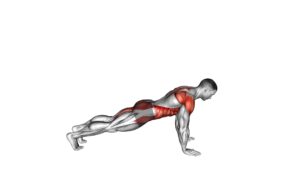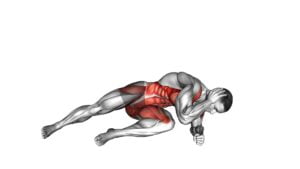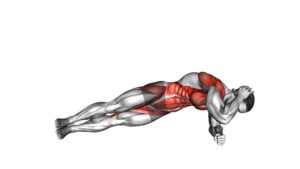Side Plank (male) – Video Exercise Guide & Tips

Get ready to strengthen your core with the Side Plank exercise. This video exercise guide and tips will show you the proper form and variations for the Side Plank specifically designed for men. Avoid common mistakes and learn expert tips to increase the difficulty of this exercise.
Watch This Exercise Video
Incorporate the Side Plank into your workout routine and experience the benefits of a stronger and more stable core. Let's get started!
Key Takeaways
- Improved core strength and stability
- Targeted oblique muscle development
- Stronger and more toned abs
- Enhanced stability and balance
Benefits of Side Plank for Men
You will experience improved core strength and stability by incorporating side planks into your workout routine. Side planks are a highly effective exercise that specifically target the oblique muscles, which are crucial for men looking to achieve a well-defined, masculine physique. By regularly performing side planks, you can expect to develop stronger and more toned abs, as well as a firmer midsection.
One of the key benefits of side planks for men is that they engage the deep core muscles, including the transverse abdominis and the muscles of the lower back. This not only helps to improve your overall core strength, but also enhances your stability and balance, which is essential for performing other exercises and activities.
To properly perform a side plank for men, start by lying on your side with your legs extended and your forearm resting on the ground. Lift your hips off the ground, creating a straight line from your head to your feet. Engage your core and hold this position for 30-60 seconds, making sure to breathe steadily throughout. Repeat on the other side.
By incorporating side planks into your workout routine, you won't only strengthen your core and improve stability, but also enhance your overall athletic performance.
Now, let's move on to the subsequent section, where we'll discuss the proper form for side plank (male).
Proper Form for Side Plank (Male)
To perform the side plank exercise correctly, it's important to focus on maintaining proper hip alignment. Keep your body in a straight line from head to toe, engaging your core muscles to prevent sagging or tilting.
Additionally, be mindful of avoiding shoulder strain by keeping your supporting shoulder stacked directly under your elbow.
Correct Hip Alignment
Achieving proper hip alignment is crucial for performing the side plank exercise correctly. Hip stability and proper alignment are essential to maintain balance and engage the targeted muscles effectively.
To achieve correct hip alignment, start by lying on your side with your legs extended and stacked on top of each other. Place your elbow directly under your shoulder, aligning your forearm with your body.
Engage your core and lift your hips off the ground, creating a straight line from your head to your feet. It's important to keep your hips lifted and avoid sagging or rotating.
Engaging Core Muscles
To engage your core muscles properly in the side plank exercise, maintain the correct hip alignment and focus on keeping your body in a straight line from head to feet. Engaging your core muscles is crucial for strengthening your obliques and improving stability.
As you lift your hips off the ground, squeeze your abdominal muscles and imagine pulling your belly button towards your spine. This will activate your deep core muscles and help you maintain a stable position.
Avoid letting your hips sag or rotate backward, as this can take the focus away from your core and increase the risk of injury. By maintaining proper alignment and engaging your core muscles, you'll maximize the benefits of the side plank exercise and effectively strengthen your obliques.
Avoiding Shoulder Strain
To avoid shoulder strain while performing the side plank exercise, ensure proper form by keeping your shoulders stacked directly above your supporting arm. This alignment is crucial in preventing injuries and maximizing the effectiveness of the exercise. When your shoulders aren't properly aligned, excessive strain is placed on the shoulder joint, increasing the risk of injury.
To modify the side plank for beginners, you can start by bending your bottom knee and placing it on the ground for added support. This modification reduces the load on the shoulder and allows you to focus on engaging your core muscles. By gradually building strength and stability, you can progress to performing the side plank with both legs straight.
Now let's explore variations and progressions for side plank (male).
Variations and Progressions for Side Plank (Male)
Now let's talk about the different difficulty levels for progressing in the side plank exercise.
There are various variations and progressions that you can incorporate to challenge yourself and improve your strength and stability.
Additionally, it's important to focus on maintaining proper form and alignment throughout the exercise to maximize its effectiveness.
Keep these tips in mind as you explore the different variations and progressions for the side plank.
Difficulty Levels for Progression
As you progress in your side plank exercises, you can challenge yourself by incorporating variations and progressions.
There are different difficulty levels you can try to continue pushing yourself and building strength.
One way to increase the difficulty is by adding a leg lift to your side plank. This requires you to lift your top leg off the ground while maintaining the proper side plank position.
Another progression level is to perform a side plank with a twist. In this variation, you'll rotate your torso and reach your top arm towards the ceiling, adding an element of rotation and further engaging your core muscles.
These modifications to the side plank exercise will help you continue to improve and advance in your fitness journey.
Form and Alignment Tips
As you continue to progress in your side plank exercises, incorporate variations and progressions to challenge yourself and further improve your form and alignment. Here are some side plank variations and core engagement techniques to keep you engaged and motivated:
- Side Plank with Leg Lift: Lift your top leg while maintaining a strong side plank position. This variation targets the obliques and adds an extra challenge to your core stability.
- Side Plank with Arm Reach: Extend your top arm overhead while holding the side plank. This variation increases the demand on your shoulder stability and engages the muscles of your upper back.
By exploring different side plank variations, you can target different muscles and enhance your overall strength and stability. These variations also help to prevent plateaus in your training.
Now, let's move on to the next section to learn about common mistakes to avoid in side plank (male).
Common Mistakes to Avoid in Side Plank (Male)
To avoid common mistakes in Side Plank (Male), ensure your positioning and form are correct. Proper form is essential for maximizing the benefits of this exercise and preventing injuries. One common mistake is letting your hips sag towards the ground. This can put excessive strain on your lower back and compromise the effectiveness of the exercise. To avoid this, engage your core muscles and lift your hips so that your body forms a straight line from head to toe.
Another mistake is placing your supporting arm too far forward or too far back. This can cause instability and make it harder to maintain balance. Instead, position your supporting arm directly underneath your shoulder, with your elbow bent at a 90-degree angle.
Lastly, avoid holding your breath while performing the side plank. Remember to breathe continuously and deeply throughout the exercise to oxygenate your muscles and maintain proper form.
Tips for Increasing the Difficulty of Side Plank (Male)
To increase the difficulty of Side Plank (Male), challenge yourself by incorporating variations and progressions into your routine. By increasing intensity and modifying technique, you can take your side plank to the next level. Here are some tips to help you increase the difficulty:
- Elevate your feet: Place your feet on an elevated surface, such as a bench or step, to increase the demand on your core muscles. This will require more stability and strength to maintain proper form.
- Add a leg lift: Lift your top leg while in the side plank position. This won't only engage your core but also activate your hip muscles. Start with small lifts and gradually increase the height as you get stronger.
- Progression: Once you have mastered the leg lift, try extending your top leg straight out in front of you while maintaining the side plank position. This will further challenge your stability and core strength.
- Variation: Instead of lifting your leg, you can also try bringing your top knee towards your chest and then extending it back out. This dynamic movement adds an extra challenge to the exercise.
Incorporating Side Plank Into Your Workout Routine
Include Side Plank in your workout routine to strengthen your core and improve overall stability. Incorporating side plank exercises into your routine can bring numerous benefits to your fitness journey.
Side plank is a challenging exercise that targets not only your core muscles but also your shoulders, hips, and glutes. By adding this exercise to your routine, you can enhance your core strength, which is essential for maintaining proper posture, preventing injuries, and improving overall athletic performance.
To incorporate side plank into your workout routine, start by performing it for a few seconds on each side and gradually increase the duration as you get stronger. You can also add variations to make it more challenging, such as lifting your top leg or adding a side plank with a knee tuck. It's important to maintain proper form throughout the exercise to maximize its benefits and avoid injury.
By including side plank in your workout routine, you can improve your core strength, which will have a positive impact on your overall stability and balance. This exercise can also help you develop a strong and toned midsection, contributing to a more aesthetic physique.
Frequently Asked Questions
How Long Should I Hold the Side Plank Exercise?
To get the most out of the side plank exercise, it's important to know how long to hold it. The duration of the side plank can vary depending on your fitness level and goals.
It's generally recommended to start with 30-second holds and gradually increase the time as you get stronger. Holding the side plank for 1-2 minutes is a good target to aim for.
Is It Necessary to Warm up Before Doing Side Plank?
Before doing side plank, it's highly recommended to warm up your body. Warming up helps to prepare your muscles and joints for the exercise, reducing the risk of injury.
Incorporating side plank into your workout routine offers numerous benefits, such as strengthening your core, improving balance, and targeting the oblique muscles.
However, it's important to be aware of common mistakes, such as sagging hips or holding your breath. By warming up and practicing proper form, you can maximize the benefits of side plank.
Can Side Plank Help With Reducing Love Handles?
Side plank variations and benefits can help reduce love handles. By engaging your oblique muscles, side planks target the sides of your waist and can contribute to slimming down that area.
Regularly incorporating side plank variations into your workout routine can increase core strength and stability, leading to a more toned midsection.
Remember to maintain proper form and gradually increase the duration and difficulty of the exercise for optimal results.
Are There Any Modifications for Individuals With Wrist Pain?
If you're dealing with wrist pain during side planks, don't worry. There are modifications you can try to alleviate the discomfort.
Instead of supporting your weight on your hands, you can use your forearm for stability. This puts less strain on your wrists while still engaging your core muscles.
Alternatively, you can also try alternative exercises like a side plank with a knee bend or a side plank with a hip dip. These variations provide similar benefits without aggravating your wrist pain.
Can Side Plank Help in Improving Posture?
Side plank is a great exercise for improving posture. It targets your core muscles, which play a crucial role in maintaining proper alignment and stability. By strengthening your core, side plank helps you stand tall and straight, reducing the risk of slouching or hunching over.
To progress in side plank variations, you can try lifting your top leg or adding a dumbbell for extra resistance. Remember to engage your core and maintain proper form throughout the exercise for maximum benefits.
Conclusion
Incorporating side plank into your workout routine can provide numerous benefits for men. By maintaining proper form and avoiding common mistakes, you can effectively strengthen your core, improve balance, and increase overall stability.
To challenge yourself further, try variations and progressions of the side plank exercise. Remember to consult with a fitness expert or trainer to ensure you're performing the exercise correctly and safely.
Make side plank a regular part of your routine to enhance your fitness level and achieve your goals.

Author
Years ago, the spark of my life’s passion ignited in my mind the moment I stepped into the local gym for the first time. The inaugural bead of perspiration, the initial endeavor, the very first surge of endorphins, and a sense of pride that washed over me post-workout marked the beginning of my deep-seated interest in strength sports, fitness, and sports nutrition. This very curiosity blossomed rapidly into a profound fascination, propelling me to earn a Master’s degree in Physical Education from the Academy of Physical Education in Krakow, followed by a Sports Manager diploma from the Jagiellonian University. My journey of growth led me to gain more specialized qualifications, such as being a certified personal trainer with a focus on sports dietetics, a lifeguard, and an instructor for wellness and corrective gymnastics. Theoretical knowledge paired seamlessly with practical experience, reinforcing my belief that the transformation of individuals under my guidance was also a reflection of my personal growth. This belief holds true even today. Each day, I strive to push the boundaries and explore new realms. These realms gently elevate me to greater heights. The unique combination of passion for my field and the continuous quest for growth fuels my drive to break new ground.



